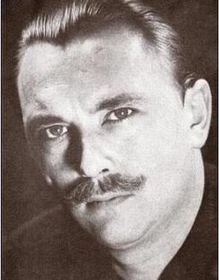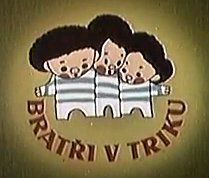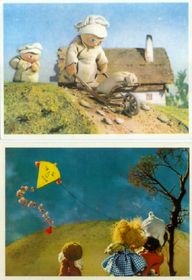 Jiří Trnka
After graduating from the Prague School of Arts and Crafts, Trnka created a puppet theater in 1936. This group was dissolved when World War II began, and he instead designed stage sets.
Jiří Trnka
After graduating from the Prague School of Arts and Crafts, Trnka created a puppet theater in 1936. This group was dissolved when World War II began, and he instead designed stage sets.
With the training received in the school of arts and his experience working in a printmaking workshop, Trnka soon began a successful career as an illustrator. He was hired by the Prague publishing house Melantrich, and his first illustrated work was Mr. Boška's tiger by Vítězslaw Šmejc, published in 1937. Since then, Trnka illustrated numerous children's books. Throughout his life, he illustrated 130 works of literature, most of them for children. Especially famous are his illustrations for the tales of the Brothers Grimm. Also related to his native folklore are his illustrations for Bajaja by Vladimír Holan, published in 1955, that would also be the starting point for his future in animation. In addition to the above, Trnka illustrated, among many other books, the tales of Andersen and Perrault, the fables of La Fontaine, The Thousand and One Nights, several works of Shakespeare and Lewis Caroll's Alice in Wonderland.
 At the end of World War II, he founded with Eduard Hofman and Jiří Brdečka a real study animation, called Bratři v triku. He began his activity in the study of animation by making some short films: Zasadil dědek řepu (Grandfather planted a beet, 1945); Zvířátka a Petrovští (Animals and Bandits, 1946), Pérák a SS (The Springer and the SS men, 1946), an anti-Nazi film, and Dárek (The Gift, 1946). Despite his early success, Trnka did not feel comfortable with traditional animation, which in his opinion required too many intermediaries that prevented him from freely expressing his creativity. In the fall of 1946 he first considered puppet animation films, and began to experiment with the help of Břetislav Pojar.
At the end of World War II, he founded with Eduard Hofman and Jiří Brdečka a real study animation, called Bratři v triku. He began his activity in the study of animation by making some short films: Zasadil dědek řepu (Grandfather planted a beet, 1945); Zvířátka a Petrovští (Animals and Bandits, 1946), Pérák a SS (The Springer and the SS men, 1946), an anti-Nazi film, and Dárek (The Gift, 1946). Despite his early success, Trnka did not feel comfortable with traditional animation, which in his opinion required too many intermediaries that prevented him from freely expressing his creativity. In the fall of 1946 he first considered puppet animation films, and began to experiment with the help of Břetislav Pojar.
 Špalíček
Throughout his career he experimented with different animation techniques, from traditional cartoons in his first shorts to animation with shadow puppets. However, his preferred method, and that which gave him worldwide fame, was stop-motion puppet work.
Špalíček
Throughout his career he experimented with different animation techniques, from traditional cartoons in his first shorts to animation with shadow puppets. However, his preferred method, and that which gave him worldwide fame, was stop-motion puppet work.
Jiří Trnka passed away in 1969 at the relatively young age of 57.
